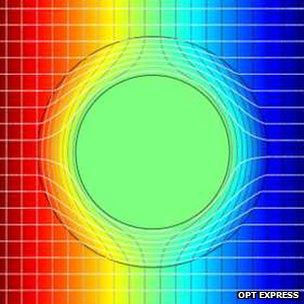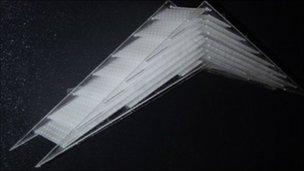Invisibility cloaks: Will we ever really have them?
- Published
- comments

A number of ways exist to mimic cloaking - like artist Liu Bolin's - but more flexible solutions await
You've seen the films, you've read the popular science stories. It's time to ask: when will you have your invisibility cloak?
Hold your horses. It's looking like a great many things inspired by cloaking science will come to pass before then.
Behind most cloaking ideas is the use of metamaterials - materials whose properties are purposefully designed, defined not by chemistry but by the materials' size, shape and structure.
They are already starting to crop up in consumer technology, and could find widespread use in applications ranging from computers to concert halls.
It is a simple idea whose scientific foundations are dizzyingly complex.
At its simplest, explains John Pendry of Imperial College London, "you just want to grab hold of the light coming from an object, guide light around the hidden thing, and then return it to the path it was going on originally - and that's easier said than done."
Another alternative is to find out what a given object will do to incident light beams and create a cloak that does the exact opposite - that's the aim of what are known as plasmonic metamaterials.
Luckily, there are many ways to pull off the invisibility trick. The metamaterials approach seems to be the most promising, but a number of what might be called optical tricks have also cropped up.
Prof Chris Phillips outlines three of the ways to make things invisible
What started it all was a paper in Science, external in 2006 by Prof Pendry and colleagues David Smith and David Schurig of Duke University, laying out the theory for the idea.
David Smith says that after the first microwave-region demonstration, also in Science, external, media interest was immediate and voracious.
"I thought, 'Let's demonstrate where this technology is actually at'. I thought people would look at it and say 'not so interesting, we'll check back in a couple of decades'," he told BBC News.
"We rushed out an experiment to throw cold water on it and it's taken years for the cold water to stick."
Invisibility of any sort was just too enticing. The BBC and others noted, for example, when a flat region a 3D object was hidden in "free space".
Here's the problem: these light-guiding structures need to be not much bigger than the wavelength of the light they're hiding from. For visible light, that's just a few hundred billionths of a metre.
So all these efforts either hide things in wavelengths longer than we can see - radio, microwaves and a bit of infrared - or hide objects so small we can't see them. And they're all stiff as a board.
The eventual outcome, Prof Pendry says, "is going to be very far from what most people would think of as a cloak: something thin and flexible, which you can wrap around yourself and change its shape".
"This sounds like being a wet blanket - or a wet cloak if you prefer - I don't see that ever being a reality. And to be honest, that's not the target of scientists."
But stay with me - the targets of scientists are still pretty interesting.
"There's a whole host of other stuff that's spun off because people have realised that light waves are not the only sort of waves you might want to hide from," Prof Pendry says.
You see, much of the mathematics behind cloaking (called "transformation optics") applies just the same - and is likely to find quicker application - in other contexts.
We've already seen bids to cloak magnetic fields, which could find use in security applications, and even cloaks for heat that might keep future computers' processors cool.
Still on the drawing board, in the form of an unpublished paper, external, is cloaking buildings and dams from seismic waves.

Many of the same principles behind optical cloaking underlie the thermal and magnetic versions
And like many areas of science where mathematics makes a first ruling on what's possible before the engineers arrive, it gets weirder: how about a "spacetime cloak" outlined in the Journal of Optics, external that can hide events in time?
Some ideas Prof Pendry calls "wacky suggestions and not serious possibilities". Others, such as acoustic cloaks that hide from sound, may actually be easier to pull off.
"An acoustic cloak will work even better than an electromagnetic one," says Andrea di Falco of the University of St Andrews. "The analogy is powerful, and there are some fields where it is possible to do better - you don't have the limitations you have with light."
It's not too hard to imagine, say, metamaterials-enhanced noise-cancelling headphones, or concert halls with flawless acoustics.
But what about microwaves, where the whole effort began - written off "because they're invisible anyway"?
"They're highly visible to cell phones, PDAs, to radar," says Prof Smith. "You wouldn't want to fly in a plane that didn't have good radar that sees in the microwave."
He has hinted here at what will quietly (and presumably invisibly) occupy a lot of metamaterial thoughts in the defence industry: how to make planes and boats and tanks invisible to various wavelengths of light and sound.
Left behind
Back to civilian territory, though: commercially available mobile phones already incorporate simple metamaterial antennas, and metamaterial lenses could hugely boost imaging and microscopes.
And though it seems pedestrian compared to invisible wizards, metamaterials might find their biggest strengths in electronics.
First off, metamaterials' ability to manipulate light's speed could lead to a faster internet, external.

Acoustic cloaking could make for better sound in a wide range of places - or no sound at all
Applying the same ideas to electrons and "matter waves", Andrea Alu at the University of Texas at Austin told BBC News, "may lead to a complete transformation of the current field of electronics".
But Prof Pendry says the metamaterial "killer app" is a mix of the two.
"We want to guide light with the same precision as electrons, and make light 'talk' to light in the same way that electrons can - the way that one current can turn another on and off," he says - making for faster, smaller "all-optical" computers.
For none of these researchers, though, is the classic "cloak" the ultimate goal.
As Prof di Falco says: "Of course the cloaking is what catches the imagination of the public but... it's more of a legacy that metamaterials are leaving behind."
- Published12 November 2012
- Published25 May 2012
- Published27 March 2012
- Published26 January 2012
- Published26 September 2011
- Published1 February 2011
- Published24 June 2011
- Published4 November 2010